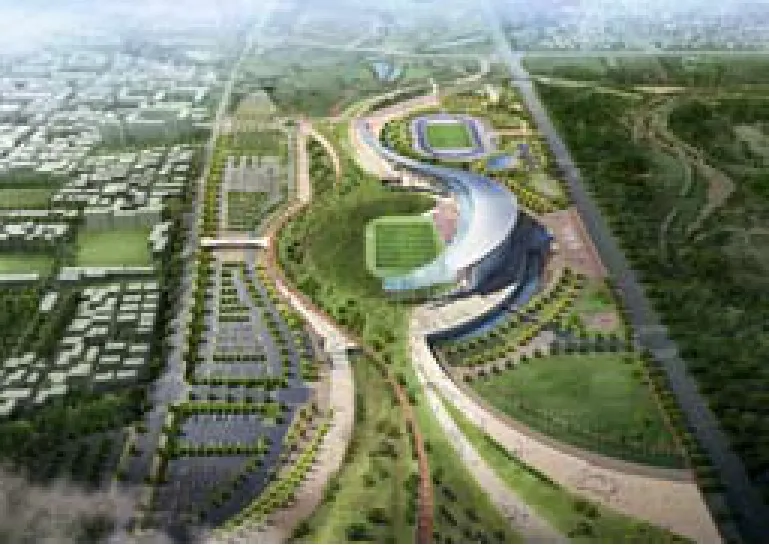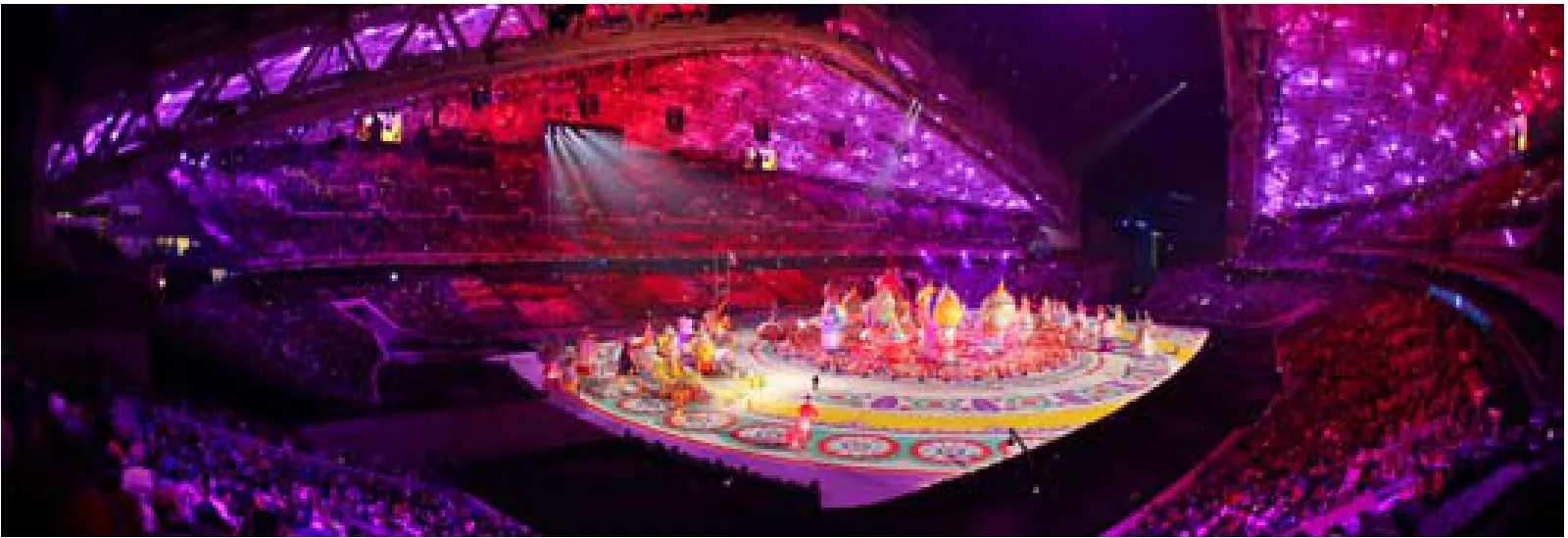节能减排、重复使用、回收利用
——可持续冬奥会的关键因素
杰伦特·约翰,杰瑞·安德森/Geraint John, Jerry Anderson
徐知兰 译/Translated by XU Zhilan
节能减排、重复使用、回收利用
——可持续冬奥会的关键因素
Reduce, Reuse, Recycle: The Key to a Sustainable Winter Olympics
杰伦特·约翰,杰瑞·安德森/Geraint John, Jerry Anderson
徐知兰 译/Translated by XU Zhilan

1 维尔2015年世界锦标赛/Vail 2015 World Championships

2 都灵冬奥会/Torino Winter Olympics(图片来源/Credit: Dave Black)

3 丹佛空中大跳跃活动/Denver Big Air(图片来源/Credit: Camara Photography)
针对这项在全球最大的城市之间开展的全世界最庞大的赛事,博普乐思建筑事务所的项目策划团队利用其在赛事运作方面的专业背景为上百万来访者提供了他们的体验。我们理解赛事错综复杂的各个方面,也理解整体设计和运营的重要性,只有这样才能让普通观众和爱好者们获得衔接平顺的体验,也能让各座城市的社区获得积极的回报。
我们已经在全球完成了2000多个项目,亲手策划和监督完成的大型项目包括12届奥林匹克运动会、5届国际足球联盟世界杯、31届美国橄榄球超级碗大赛和橄榄球世界杯赛。尤其是奥运会最近已成为万众瞩目的体育盛会,其组委会也在将奥运会组织成真正可持续发展赛事的道路上大幅前进,这一切不仅通过建成环境,也通过运营机制和对赛后遗产的策划得以实现。
作为赛事策划者,我们不仅具有更多的道德责任,也更经常与政府组织的法律法规和体育赛事主办方的官方指令产生密切的联系——例如,倡导可持续发展《奥林匹克2020议程》或国际足球联盟的“绿色目标倡议”等,都更进一步推动了围绕重大项目展开的可持续发展的投入。
冬奥会作为研究如何筹备、设计和运行一项可持续发展项目的对象也非常有趣。由于运动项目、气候、形式与赛程等赛事特点与夏季奥运会的要求迥然不同,冬奥会的室外赛场更倾向于使用临时设施——而不是新的永久观众席建筑。这也由此让冬奥会本身成为一项更有可能实现重复使用和更为可持续发展的活动。在过去的10年里,我们也同样见证并参与了越来越多符合绿色建筑标准的永久奥运场馆的建设,当时临时设施尚不在考虑范围内。由于我们理解并设计了几十个符合绿色建筑标准的场馆设施,将绿色元素纳入到我们的设计中是我们的第二天性。
考虑到赛事本身的特点,我们广泛的研究和经验都表明,可持续发展的基本原则——节能减排、重复使用、回收利用——可以推广到所有的设计领域,包括冬季赛事的场馆。
节能减排
设计效率在可持续发展建筑中具有至关重要的作用。创新的轻质结构将减少所需的建筑材料数量,并使用在生产过程中减少排放CO2的材料。这样既减少了总体能耗,也节约了建设成本;材料越少,设计越简单,就能节省越多的能源和资金。
我们也同样考虑了可持续、可回收利用以及来自本土的建筑材料。例如,木材就比钢材更易加工。它通常都能在本地获得,并形成巧妙而简单的结构设计。其他的考虑因素还包括交通运输和地形环境这两方面。就前者而言,海运消耗的能源最少,空运能耗最多。在建设施工的方面,最佳方案是利用现有地形,比如将平台建在山坡上。
为了达到其他方面的节能减排效果,可持续的设计也应该关注如何最大程度减少能耗的措施,如可以通过调节建筑和玻璃幕墙朝向、建筑围合结构的有效隔热,以及安装自然通风管道、荧光灯管和可调节遮阳板等措施来实现。通过这些措施的引进,我们可以在整体上有效地利用建筑各部分的高效管理系统,以满足复杂而不断变化的要求。
尽管物理空间的设施是我们实现可持续发展的重要手段,却并非可持续策划的主导要素。仔细考虑一下,冬季奥运会将会持续两周,而在此期间将有几百万观众到场。我们不得不考虑如何才能减少实际消耗的运营成本。我们要如何管理人们观看赛事、参加比赛和在其中工作的过程,让他们成为可持续发展措施的一部分呢?
我们对赛事进行整体设计、策划和考虑运作方法,并为此打下了坚实的基础。为了减少对环境的影响,并反过来减少赛事的碳足迹,我们提出了一种将会带来深远影响的创造性提议。举例来说,我们会提出建议实施一项植树计划,以帮助减少碳排放,或采用可再生能源减少能耗。在考虑赛后遗产的问题时,这个方法至关重要。举办赛事的国家常常在太阳能板或相关技术方面有明确的激励机制,它为我们的赛事客户提供支付能源账单的信用。其他的替代能源激励策略,如“风信用”,则鼓励使用风能科技为赛事提供能源。
对冬季奥运会而言,水分保持也非常关键,因为耗费巨大——需要消耗大量的水资源和电能——在整个赛事过程中就需要生产好几吨雪。未来冬季奥运会将使用更多替代能源来生产比赛用雪,并将找到独特的方法建立和覆盖蓄水池,以确保水分不会因蒸发而流失。
其他方面的努力,包括鼓励、规划能够完成大规模运输的基础设施将成为赛事的关键因素。这是一个极大减少赛事本身对环境影响的契机。
重复使用
冬季奥运会可以有许多方式实现重复使用的策略——包括从对现有场馆的重复使用,到赛事结束后调整其中部分设施的使用功能。
For the world's largest events, in the world's biggest cities, Populous' event planning team uses its technical expertise of event operations to shape millions of visitors' experiences. We understand the intricacies of the event and the importance of a holistic approach to the design and operations of events so that fans and viewers have a seamless experience and cities are able to see the positive returns for their community.
We've worked on more than 2000 projects across the globe and had our hand in planning and overseeing major events including 12 Olympic Games, 5 FIFA World Cups, 31 Super Bowls and the Rugby World Cup. The Olympic Games, in particular, have come into the spotlight recently as the Organizing Committees have taken strides to create truly sustainable events, both through the built environment, operational efforts and planning for the post-games legacy.
As event planners, not only do we have a moral responsibility to do this, but often we adhere to legislation from government organisations and directives from sport's governing bodies–Olympic Agenda 2020, for example, or FIFA's Green Goal initiative–that help further drive sustainable efforts surrounding major events.
The Winter Olympics serve as an interesting study as to how to prepare, design and operate a sustainable event. Because of the nature of the Games, which differs in many ways due to sport, climate, topography, and program from the Summer Olympics requirements, the Winter Olympics outdoor venues tend to be made up of more temporary facilities–rather than new, permanent spectator structures. This inherently lends itself to a more reusable and more sustainable event. In the past decade, we've also seen and been involved with the proliferation of permanent Olympic buildings that are designed to subscribe to LEED standards when temporary facilities aren't an option. Since we understand and have designed dozens of LEED certified facilities, incorporating green attributes into our designs is second nature.
Because of the nature of the general principals of sustainability – reduce, reuse and recycle – can be applied to all areas of design, including the architecture of winter sport.
Reduce
Design efficiency is crucial in developing sustainable structures. Innovative lightweight structures will reduce the amount of building material required, and make use of materials that produce less CO2when manufactured. This reduces both the overall embodied energy and financial costs; the less material and the simpler the designs, the more you save in energy and money.
We can also consider sustainable, recycled and locally sourced materials. Wood, for example, is much easier to manipulate than steel. It can usually be sourced locally, and developed into clever but simple structural solutions. Other factors to be considered include transportation and topography. In the first instance sea freight uses the least embodied energy and air freight uses the most. When it comes to construction, it is best to work with the existing lie of the land, for example, building terracing onto the natural slope of a mountain.
To achieve other savings, sustainable design should also look to minimise heating through considered building and glazing orientation, effective building envelope insulation, and installation of natural ventilation shafts, light tubes and adaptable solar shading. By introducing these measures, we can incorporate the effective use of efficient building management systems to meet complex fluctuating demand.
While the physical facilities play a role in our approach to sustainability, they are by no means the dominant component of our sustainability plan. Consider this – the Winter Olympics last for two weeks and welcom millions of visitors in that time. We are challenged to look at how we reduce the actual operational costs. How do we handle the people visiting, attending and working the Games so they are part of our approach to sustainability?
Our holistic approach to the design, planning and operations of the event allows us to be on the ground floor. To reduce the environmental impact, and in turn, the event's carbon footprint, we come up with creative suggestions with a longterm impact. For example, we'll recommend a tree planting program to assist in reducing CO2emissions, or renewable energy sources to reduce energy demands. When considering the postgames legacy, this approach is critical. Often, there are clear incentives through the state or country where the games are hosted to invest in solar panels or technology that offers our event clients credits against their energy bills. Other alternative energy incentives, like Wind Credits, encourage the use of wind generation technology to power events.
For the Winter Olympics, water retention is critical, as it is costly – in both water and electricity–to produce the tons of snow used during the course of the event. Future Winter Olympics will be much more tuned into alternative energy use to produce snow and finding unique ways to incorporate retention ponds and the ability to cover these ponds to ensure water isn't lost due to evaporation.

4 伦敦奥运会开幕式/London Opening Ceremony

5 伦敦2012年奥运会沙滩排球场地/London 2012 Beach Volleyball Arena
应该可以理解,重复使用现存场馆是最可持续的选择。在规划一座新建筑时,当务之急是要调查清楚能否重新使用现存的建筑,是否能够进行重新装修,甚至进行大幅度的重新设计。可供重新使用的建筑对于举办一次性体育赛事的城市而言——如奥运会——也尤为重要。由于这些建筑可进行多次使用,并且比永久性建筑更加轻质,因此它们能够在建设和运输环节中节约大量能源。
如果新建筑的建设必不可少,我们也必须将它们设计得更为灵活,以便在其中举办所有类型的赛事,并且每年至少能够运营一定天数。这样的策略不仅与夏季奥运会和冬季奥运会关系密切,对于其他专门为一支团体或一座城市设计的、更为传统的体育场馆而言也十分重要。如果一座体育馆能够容纳完全不同类型的赛事,如橄榄球或棒球比赛,同时也能举办流行音乐会或大型集会,它就能因为这种更高效利用能源的方式成为终其一生都更可持续的建筑。
如果(由于缺少现成的体育场馆而)无法实现直接的重复使用,或(由于观赛视线不佳或看台踏步进深不合适等建筑结构或空间设计问题而)不适合进行重复使用,也可以采取其他的方式,包括建设能够拆除并事后在别处重新组装的临时建筑或赛场。
临时建筑被统称为“覆盖设计”,它们将现有设施与临时设施组合在一起,以对场馆或场地的最佳利用为目标,实现一场赛事的有效运作。覆盖设计是一个动态过程,能够帮助形成一项赛事的运行策划,在外观和功能之间、永久建筑和临时设施之间找到平衡。
临时搭建的模块化看台结构也适用于一次性赛事接待的观众流量。举例来说,2012年的伦敦奥运会体育馆在奥运会开赛期间容纳了8万名观众,并能够在今年秋天结束后减少为5.4万名观众的容量。与此类似的是,2014年韩国仁川主办亚洲杯足球赛的主场馆容纳了7万名观众,但其容量最终会减少到3万人,并成为一座供当地社区使用的公园。索契奥运会的奥运场馆设计则通过使用临时租用的座椅将原先3万座的规模扩大到赛时4.5万座的规模。
回收利用
回收利用的关键作用贯穿整个过程,并对于从赛事策划到物理空间设施的运营而言都至关重要。在建设、运营和必要条件下的拆除过程中,回收利用材料能够极大减少能源的消耗。
由于夏季奥运会和冬季奥运会都需要消耗大量水资源用于灌溉草坪和卫生清洁,水资源的回收利用和保护就变得尤为关键。体育馆的屋顶通常都是非常理想的雨水收集设施。例如,在悉尼的澳洲体育馆,从屋顶收集的雨水被用于冲洗厕所和灌溉球场。在像卡塔尔国家会议中心这样的会场设施里,中水收集系统被用于低速喷淋供水,以减少水资源的使用。
像钢材、铝、玻璃和混凝土这样的材料也同样可以回收利用。用于结构体系的钢材名列这份清单首位,也是最常见的可回收材料之一,因为精炼钢的生产需要耗费大量能源。事实上,在全球范围内,有60%的结构钢材都得到了回收利用——大约每年回收利用4.4亿吨钢,相当于每天回收利用150座埃菲尔铁塔。
在对赛事中的回收利用进行评估时,我们与环境管理者展开了紧密合作,针对使赛事尽可能符合可持续发展主题的议题,共同形成了一份全面的计划。这项工作经常涉及到一项重要的回收利用计划,我们建议也作为他们可持续发展实践的组成部分。它要求我们必须在沟通方面投入精力,并鼓励体育比赛爱好者也加入到这项可持续发展方案中。挪威的利勒哈默尔曾因1994年使用可食用餐盘的措施举世闻名,同样人尽皆知的是,利勒哈默尔也曾在比赛举办期间限制居民在市区内驾驶小汽车,以减少对环境的影响。这些姿态与一项规模更大且十分复杂的计划进行对话,这些计划还考虑了赛后长期遗产的问题——从大规模的场馆建筑到提供餐饮服务的方式等——它也是奥运会开始真正采用绿色方式的标志。□

6 覆盖设计/Overlay Kit of Parts

7 温哥华2010年冬奥会/Vancouver 2010

8 伦敦奥运会主赛场London Olympic Stadium(4-8 图片来源/ Credit: Populous)

9 伦敦奥运会主赛场的赛后改造/Transformed London Olympic Stadium(图片来源/Credit: Morley von Sternberg)

10 仁川亚运会赛时模式/Incheon Asian Games Mode

11 仁川亚运会赛后模式/Incheon Legacy Mode(10.11 图片来源/Credit: Populous)

12 索契冬奥会开幕式/Sochi Opening Ceremony(图片来源/ Credit: Korean Olympic Committee)
Other efforts, like encouraging and planning for the infrastructure that allows for mass transit to be a critical component of the event is key. It's an opportunity to drastically reduce the environmental impact of the event itself.
Reuse
Reuse can be implemented throughout a Winter Olympics in many fashions – from reusing existing stadia to repurposing parts and pieces used for overlay after the event ends.
Reusing existing stadia is, understandably, the most sustainable option. When planning a new building, the first thing to investigate is whether an existing building can be reused, refurbished or even given a radical redesign. Reusable structures are particularly useful for cities staging one-off sports events such as the Olympic Games. Since they can be used several times, and are lighter in weight than permanent buildings, they save enormous amounts of energy in both construction and transportation.
If a new building is necessary, we must design them to have greater flexibility so they can stage all types of events, and operate numerous days a year. This is as relevant for Summer and Winter games as it is for other, more traditional sports venues designed for a team or city. A stadium that can welcome sports as disparate as rugby or baseball, and stage pop concerts or large meetings, will be a more sustainable building over its life thanks to a more efficient use of its embodied energy.
When straight reuse isn't possible (because there is no pre-existing venue) or suitable (because of structural or physical problems like poor sight lines or terrace tread depths), other solutions, such as temporary structures or venues that can be disassembled and later reassembled elsewhere, are possible.
Temporary structures are generally called "overlay design", and they combine existing and temporary elements for the best use of a venue or site to enable efficient operation of an event. Overlay design is a dynamic process that helps to define the operational plan of an event, one that finds the balance between appearance and functionality as well as permanent and temporary components.
Temporary modular grandstand structures can also be employed to cater for a one-off influx of spectators. For example, the 2012 London Olympic Stadium, held 80,000 during the Games, and will have a reduced capacity of 54,000 once complete this autumn. Similarly, the main stadium for the 2014 Asian Games in the South Korean city of Incheon initially held 70,000 spectators, but will eventually shrink to a capacity of 30,000 and become a park for the local community. The Olympic Stadium for the Sochi Games was designed to increase its permanent capacity of 30,000 seats up to a Games time capacity of 45,000 using temporary rental seats.
Recycle
Recycling is crucial throughout the process and spans from the event planning and operations to the physical structures that support it. Through construction, operation, and when necessary, demolition, recycled materials can massively reduce embodied energy.
It's crucial to recycle and conserve the water used during the Summer or Winter Olympics since huge quantities are needed for irrigation and sanitation.The stadium roof is often ideal for collecting rainwater. For example, at ANZ Stadium in Sydney, rainwater collected from the roof is used to flush toilets and irrigate the pitch. At convention centers like Qatar National Convention Centre, a greywater capture system feeds low-flow showers to reduce water usage.
Materials such as steel, aluminium, glass and concrete can and should also be recycled. Structural steel is at the top of this list, and one of the most commonly recycled materials, because virgin steel requires huge amounts of energy to create. In fact, worldwide, 60% of structural material is recycled –around 440 million tonnes are recycled every year –the equivalent of 150 Eiffel Towers every day!
When evaluating how to recycle during the event, we work closely with environmental managers to coauthor an extensive plan looking at opportunities to make the event as sustainable as possible. Often, this involves a significant recycling program that we suggest as part of their sustainable practices. This requires some communication efforts and encourages fans to be part of the sustainable solution. Lillehammer famously used edible plates in 1994, and was also known for preventing residents from driving within the city during the games to reduce impact. These gestures speak to a larger, sophisticated plan that considers the long term legacy of the games – from massive structures to the way food is served – and is the sign of a truly green approach to the Olympic Games.□
博普乐思建筑事务所/Populous
2015-08-30

